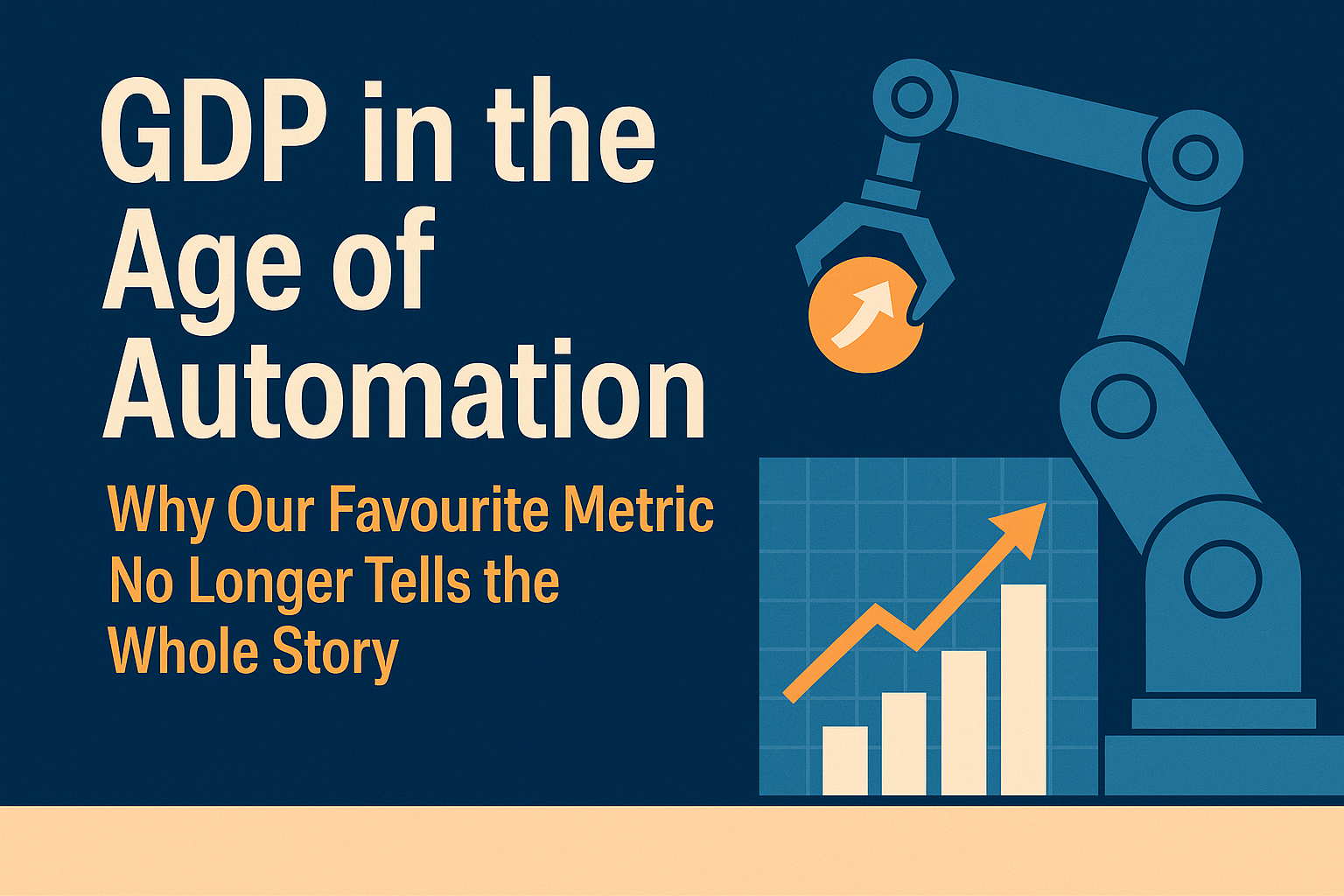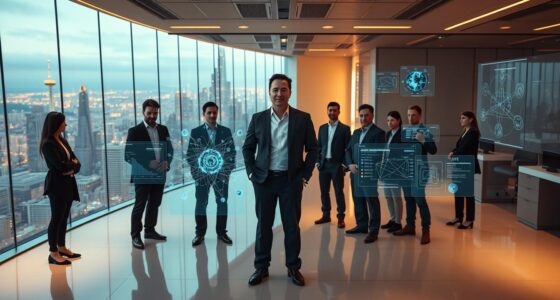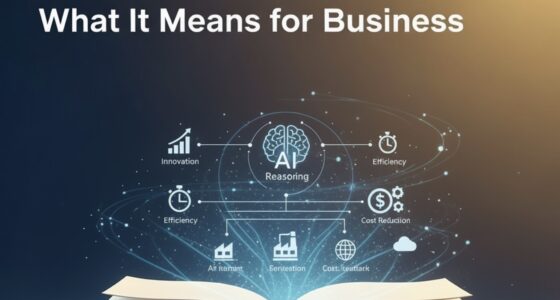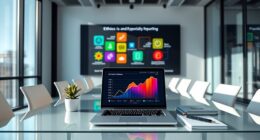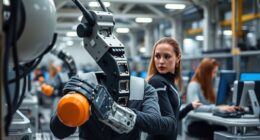AI is transforming creative industries by automating routine tasks and offering new tools to expand your artistic boundaries. While AI can generate art and assist with design, it’s unlikely to replace your unique human intuition, emotional depth, and cultural insights. Instead, it acts as a powerful collaborator, enhancing your creativity. If you want to understand how human-AI synergy is shaping the future of art, keep exploring these evolving dynamics.
Key Takeaways
- AI enhances creativity by providing new tools and insights but currently lacks genuine emotional depth and subjective experience.
- Human judgment, cultural understanding, and ethical considerations remain essential in meaningful creative work.
- AI is more a catalyst and collaborator than a replacement, automating routine tasks but not replicating human intuition.
- Concerns about AI replacing artists stem from fear of job loss and devalued authenticity, but most AI art is still recognized as human-created.
- The evolving industry suggests AI will transform rather than fully replace human creativity, emphasizing partnership over substitution.
Understanding AI’s Role in Creative Fields
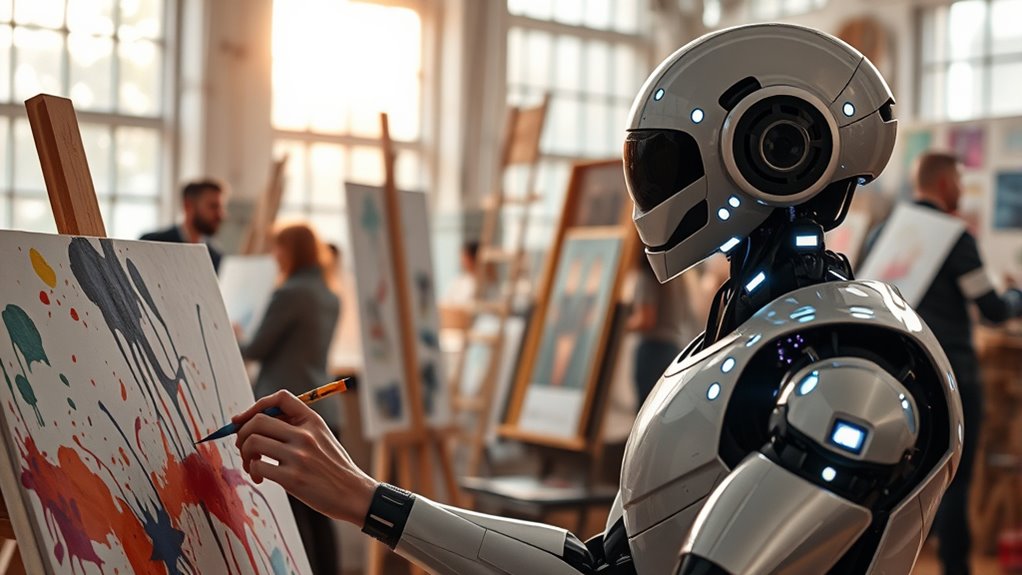
Understanding AI’s role in creative fields reveals a rapidly expanding landscape where technology is transforming how art is produced, displayed, and appreciated. You’ll notice the market is booming, expected to reach around $40.3 billion by 2033, with AI-generated art making up about 5% of the art market by 2025. This growth is driven by a 28.6% CAGR from 2025 to 2032, and increased investments from industry leaders. AI is becoming more common in exhibitions, with a 25% rise in AI art showcases over recent years. It provides new platforms and tools that push artistic boundaries, enabling creators to explore innovative ideas. The integration of advanced toilet flushing mechanisms into everyday life demonstrates how technology continues to evolve and influence various sectors. The surge in acceptance and technological progress signals AI’s deepening integration into creative industries, shaping the future of art and media. Additionally, the emergence of AI-powered creative tools is further accelerating this transformation, allowing artists to experiment with new techniques and media.
The Extent of Automation in Creative Tasks

AI’s growing presence in creative industries isn’t just about generating art or content; it also considerably automates many routine tasks. You’ll find that tasks like writing copy, generating image assets, and organizing documents are increasingly handled by AI. Currently, about 76% of marketers use generative AI for basic content creation, boosting productivity—writing more documents and coding more projects weekly. Despite this, only 20% of leaders expect AI to automate more than 30% of their daily tasks within a year. Most automation happens in non-creative areas like data entry or document management. While AI enhances efficiency, it’s also helping workers handle more customer inquiries and complex projects. Additionally, AI is often applied in Ice Cream Terminology, where understanding product classifications can streamline creative branding and marketing strategies. However, tasks requiring deep creative thinking remain less automated, highlighting that AI mainly supports, rather than replaces, human effort. Overall market projections indicate that the global AI spending was around $342 billion in 2021, with substantial growth expected, which further emphasizes AI’s role in automating routine functions across various sectors. Additionally, technological advancements continue to expand AI capabilities, making it increasingly integrated into creative workflows. Moreover, the Law of Attraction principles can be applied to foster innovation and creative inspiration within AI development teams, encouraging positive energy and collaborative success. Furthermore, understanding the hours of operation of local businesses can help teams better plan and optimize their workflow schedules, especially when coordinating with external partners or clients. Recognizing the importance of human oversight remains crucial to ensure AI tools are used ethically and effectively in creative processes.
How AI Enhances Human Creativity
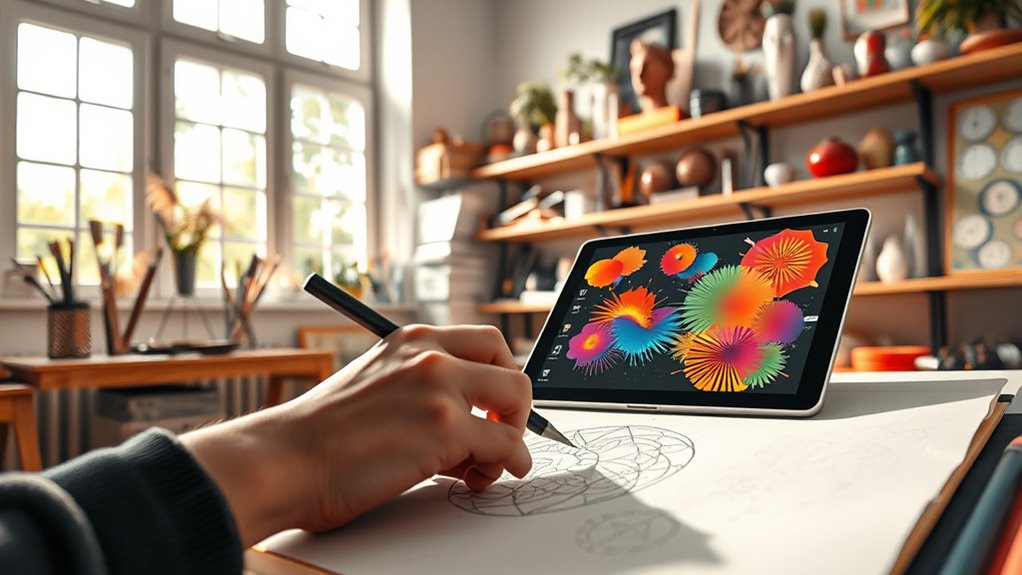
AI serves as a powerful tool that amplifies human creativity by providing new ways to generate ideas and explore concepts. You can analyze massive amounts of data to uncover unique insights, sparking fresh inspiration. Sound design techniques often make unexpected connections between diverse concepts, igniting your creative spark. During brainstorming, it introduces novel ideas and opportunities you might not have considered, expanding your creative horizons. Automated ideation allows you to generate numerous potential concepts quickly, which you can refine further. In visual arts, AI creates abstract patterns or unique compositions, giving you new starting points for projects. It also enables the creation of digital artworks and innovative art forms, pushing the boundaries of artistic expression. Additionally, understanding cookie categories helps you better utilize AI tools that rely on data collection. Exploring asset division laws can inform how you approach creative projects that involve intellectual property sharing. Moreover, AI’s ability to analyze lifestyle trends provides artists and creators with valuable insights into current cultural movements, inspiring relevant and timely work. Furthermore, knowledge of predictive modeling in educational data mining can assist educators in designing more effective and personalized learning experiences, which can also inspire creative teaching methods. Overall, AI acts as a catalyst, enhancing your ability to innovate and explore creatively.
Skills Needed for Collaborating With AI
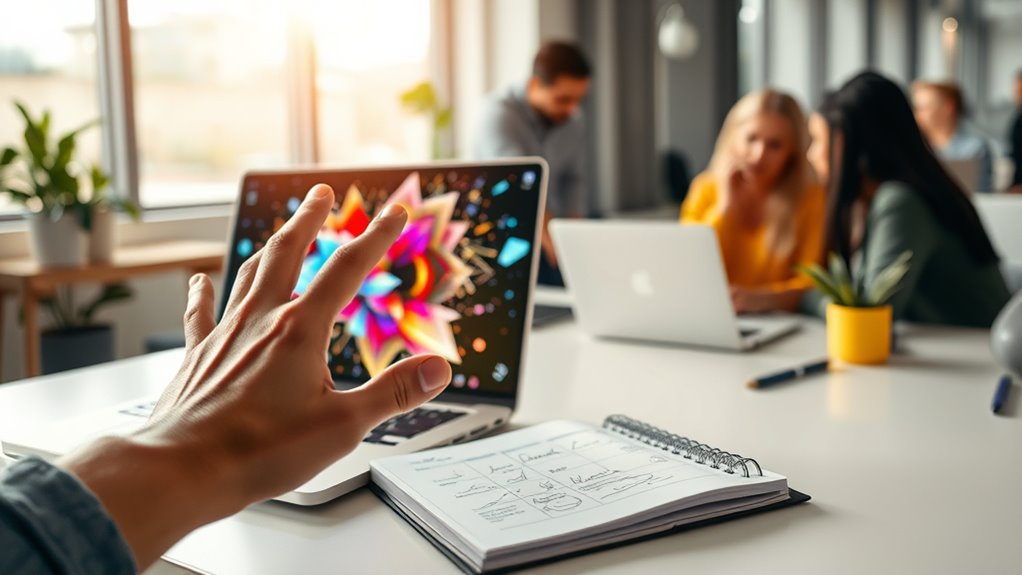
To work effectively with AI, you need to stay adaptable and quickly learn new tools as they emerge. Developing your creative collaboration skills helps you guide AI outputs and integrate them seamlessly into your workflows. By sharpening these abilities, you can maximize AI’s potential while maintaining human ingenuity at the core. AI enhances work speed and efficiency across various sectors, enabling you to respond more swiftly to changing business needs and opportunities. Cultivating a creative mindset ensures you can leverage AI’s strengths while fostering innovation. Staying informed about educational and skill-building toys can also inspire new ways to develop these crucial skills. Additionally, understanding ethical hacking principles can help you identify potential risks when deploying AI solutions responsibly. Recognizing the importance of interior design principles can inspire innovative approaches to creative problem-solving and aesthetic development. Familiarity with anime movies can broaden your cultural perspective, inspiring innovative ideas and creative thinking.
Adapting to New Tools
Adapting to new tools in the workplace requires developing a combination of technical and soft skills that enable you to collaborate effectively with AI systems. You need a solid understanding of AI tools and data literacy to interpret and leverage AI outputs. Staying adaptable through continuous learning helps you keep pace with rapid technological changes. Developing technical skills in machine learning and data visualization allows you to work seamlessly with AI systems. Soft skills like communication, resilience, and change management are essential for steering shifts and fostering teamwork. Using collaboration tools designed for human-AI interaction enhances workflow efficiency. Additionally, understanding the ethical aspects of AI deployment ensures responsible integration. Recognizing best practices for AI implementation can facilitate smoother adaptation and integration. Gaining a deeper knowledge of GMC tuning techniques can provide valuable insights into optimizing AI-driven automotive diagnostics and customization. AI’s transformative impact highlights the importance of developing these skills to stay competitive and contribute meaningfully in an AI-driven workplace. Building awareness of environmental considerations can also help ensure sustainable use of AI technologies. Furthermore, staying informed about the latest advancements in music therapy and emotional well-being can enrich your ability to leverage AI in supportive and therapeutic contexts. Considering AI security challenges is crucial to protect sensitive data and maintain trust as you integrate AI tools into your work. Together, these skills prepare you to optimize AI’s potential while maintaining your unique human contributions.
Developing Creative Collaboration Skills
Effective collaboration with AI in creative work hinges on understanding its capabilities and limitations. You need to recognize AI’s strengths in handling repetitive tasks, freeing you for innovation. Developing clarity on generative AI’s functions helps you leverage it effectively. Remember, AI complements your creativity, so human judgment remains essential for meaningful results. Staying informed about AI advances to refine your collaboration strategies is crucial. Promoting transparency about AI’s role keeps you engaged and fosters ownership. To build your skills, focus on:
- Mastering prompt engineering for precise interactions
- Crafting clear, contextual prompts for relevant outputs
- Refining prompts through iterative feedback
- Critically evaluating AI suggestions for originality and relevance
Additionally, understanding content management can aid in organizing and overseeing AI-generated outputs efficiently. Incorporating knowledge of financial aspects, such as setting clear timelines and ensuring accuracy in data handling, can also enhance your ability to manage AI-assisted projects effectively. Staying updated on AI developments can also help you adapt your strategies and maximize the benefits of human-AI collaboration. Developing a comprehensive understanding of the breed and its characteristics can further improve your ability to collaborate effectively with AI in specialized creative projects.
Ethical Challenges in AI-Driven Creativity
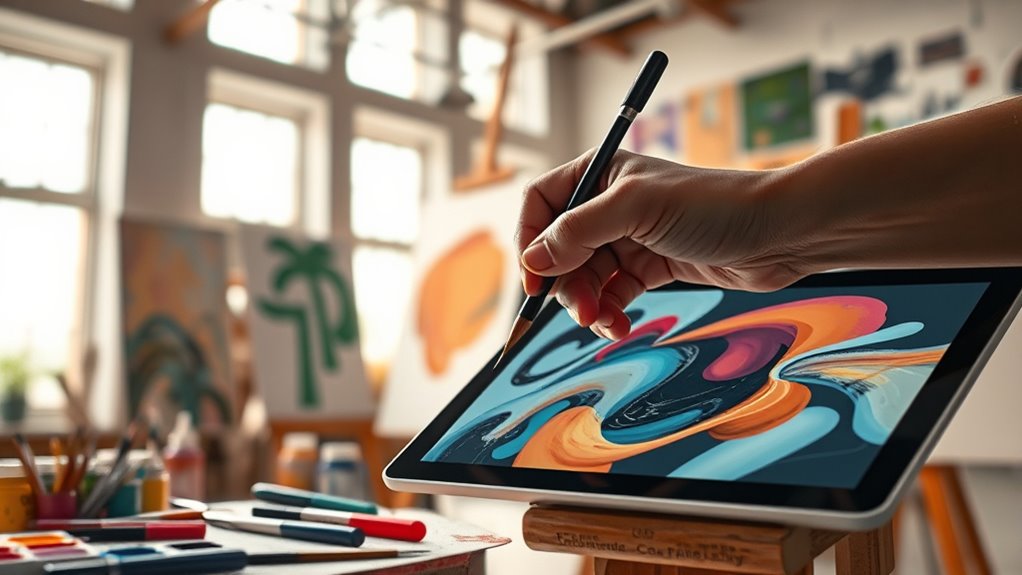
You need to contemplate how biases in training data can lead AI to produce unfair or discriminatory creative outputs. Privacy concerns also arise when large datasets are used, risking the exposure of personal information. Additionally, questions about who owns AI-generated work and how intellectual property rights apply remain unresolved in this rapidly evolving field.
Bias and Fairness
How can AI-driven creativity be truly fair when biases are embedded deep within the systems? Biases stem from data collection, which often reflects human prejudices, and algorithms that unintentionally reinforce these biases. Human-curated data can carry inherent prejudices, and a lack of diversity among development teams worsens the problem. Pre-existing social biases can be amplified, leading to unfair creative outputs that reinforce stereotypes and limit accessibility.
You might see bias manifest as:
- Unfair representation in media and art
- Reinforcement of harmful stereotypes
- Reduced diversity in creative ideas
- Disproportionate impact on marginalized groups
Addressing these issues requires ongoing efforts to diversify data, implement fairness metrics, audit algorithms regularly, and foster inclusive development teams. Without these steps, bias and unfairness threaten the integrity of AI-driven creativity.
Intellectual Property Concerns
As AI continues to push the boundaries of creativity, it also raises complex questions about intellectual property rights. You should know that, under U.S. law, AI-generated content isn’t eligible for copyright because it lacks human authorship. When it comes to inventions, traditional patent laws demand human inventors, leaving AI-created innovations in legal limbo. AI-generated logos or branding also challenge existing trademark protections. International laws complicate matters further, as different countries interpret IP rights differently. Pending legislation aims to update legal frameworks, but uncertainties remain. You might wonder who owns AI-created works—owners or developers? Plus, AI models often scrape copyrighted data without attribution, raising ethical and legal concerns about ownership, privacy, and fair use. These issues highlight the urgent need for clear, adaptive IP policies.
Future Trends and Opportunities in Creative Industries
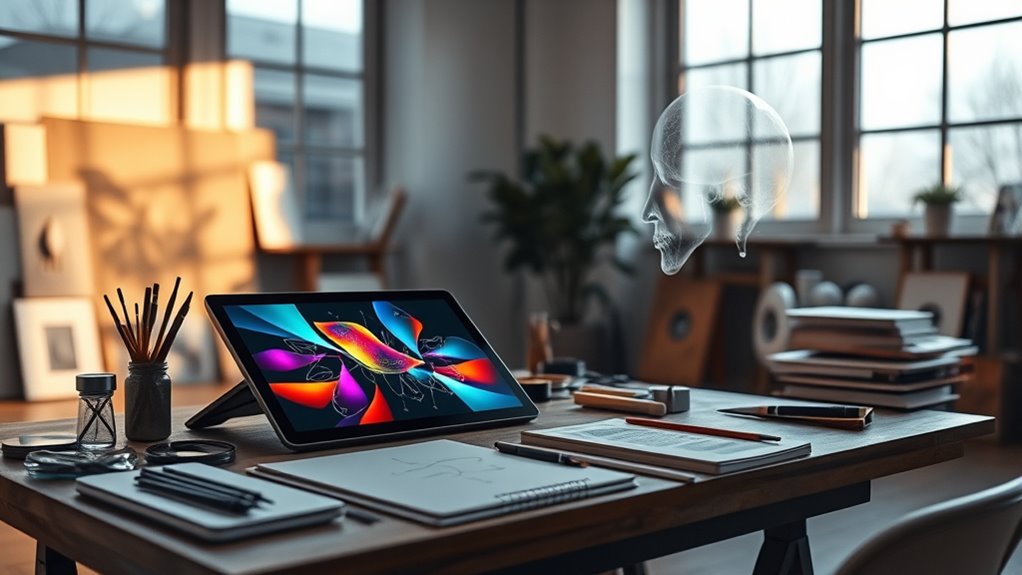
The rapid growth of AI technologies is opening up exciting new opportunities in creative industries, transforming how content is generated and personalized. You can expect AI to push creative boundaries, offering innovative tools for artists and designers. Market projections show AI in creative sectors growing to $80 billion, with the AI image market reaching $60.8 billion by 2030. In art, AI-generated works are gaining recognition, with exhibitions increasing by 25%. Opportunities include:
AI is revolutionizing creative industries with new tools, expanding artistic possibilities and market growth projections to billions.
- Exploring new aesthetic horizons through AI-assisted design
- Creating unique digital art forms impossible manually
- Enhancing personalized content for audiences
- Redefining artistic collaboration and expression
As AI becomes more integrated, the industry is set to flourish, offering fresh avenues for innovation and expanding creative possibilities worldwide.
Addressing Concerns About AI Replacing Human Artists

Many wonder whether AI will replace human artists or simply transform their roles. You might worry that AI threatens your livelihood or devalues authentic creativity. While 55% of artists fear income loss and 74% see AI art as unethical, these concerns stem from the uncertain impact of technology. Public perception shows that only about a quarter of Americans recognize AI-generated art, and over half struggle to distinguish it from human work. However, AI can assist rather than replace your creative process, helping develop complex ideas and expanding possibilities. Legal and ethical debates—like copyright issues and authorship—highlight the need for clearer frameworks. Ultimately, AI’s role is evolving as a tool that complements human talent, not a substitute for the emotional depth and originality only you can provide.
Frequently Asked Questions
How Does AI Influence Cultural Diversity in Creative Outputs?
AI influences cultural diversity in creative outputs by both expanding and limiting it. It can promote cultural exchange and preserve heritage, giving you access to diverse ideas. However, if datasets are biased, AI might reinforce stereotypes and reduce true diversity. You play an essential role in ensuring AI supports cultural inclusion by guiding its use, fostering collaboration, and balancing automation with human creativity to maintain rich, varied cultural expressions.
Can AI Develop Truly Original Ideas Independent of Human Input?
You might wonder if AI can develop truly original ideas independently. While it’s tempting to think AI can originate fresh concepts, it mostly combines existing data without genuine insight. Its creativity depends heavily on human input, guiding and refining outputs. Despite advancements, AI lacks the emotional depth and nuanced understanding that spark true originality. So, without human collaboration, AI’s ideas remain derivative, not truly innovative or independent.
What Role Will AI Play in Democratizing Creative Opportunities?
You see AI’s role in democratizing creative opportunities as a double-edged sword. On one hand, AI tools lower entry barriers, making creative work accessible to more people and enabling new roles. On the other, critics highlight that AI may favor corporate interests and deepen inequalities. Ultimately, you recognize that AI can empower individual creators but also presents challenges that could limit true democratization without ethical safeguards.
How Do Intellectual Property Rights Apply to Ai-Generated Art?
You should know that intellectual property rights don’t really protect AI-generated art because laws require human authorship, which AI lacks. When AI assists in creating, the human input is usually necessary for copyright eligibility. Developers and artists must navigate complex legal issues around training data and potential infringement. As laws evolve, your ability to protect AI-involved works will depend on the level of human contribution and ongoing policy updates.
Will AI Be Able to Replicate Emotional Depth in Creative Works?
Imagine a painter trying to capture the soul of a sunset with only a palette of colors. That’s what AI faces when trying to replicate emotional depth. You see, AI can analyze emotions and suggest ideas, but it lacks genuine experience and nuanced understanding. While it can enhance your creative process, it can’t truly replace the heartfelt connection and depth that come from human emotions and personal stories.
Conclusion
As you stand at the crossroads of innovation, remember that AI is like a powerful brush—it can add vibrant strokes to your canvas, but it’s your vision that guides the masterpiece. Rather than replace your creativity, AI becomes a loyal partner, illuminating new horizons. Together, you can paint a future where human imagination and machine intelligence blend into a masterpiece only you can create. Embrace this partnership; the future is yours to craft.

